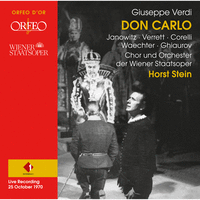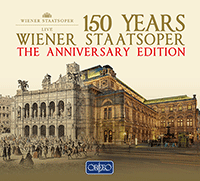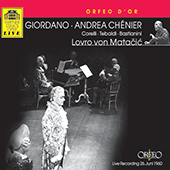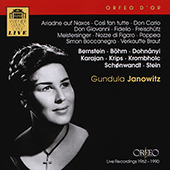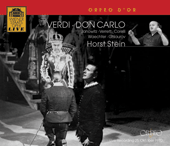Franco Corelli
Franco Corelli was born into an operatic family: his grandfather had been an operatic tenor, his elder brother sang as a baritone and two of his uncles sang in the chorus of the opera house in Ancona; although his father was a ship-builder for the Italian navy. Initially Corelli intended to follow a similar career, studying naval engineering at the University of Bologna. Encouraged by a friend, however, he entered a singing competition: he did not win, but was sufficiently encouraged to enroll as a vocal student at the Conservatory at Pesaro, subsequently leaving when he became convinced that his teachers there were damaging his voice. Henceforth Corelli studied tirelessly on his own, largely by listening to recordings of the great tenors of the past, such as Caruso, Pertile, Lauri-Volpi and Gigli, often imitating their nuances and effects.
In the summer of 1951 Corelli entered and won the singing competition associated with the Maggio Musicale in Florence, the prize for which was an appearance at Spoleto that autumn. Although he had studied Radamès/Aida for this, he judged himself not to be vocally ready, so made his début instead as Don José/Carmen. Shortly afterwards, in November 1951, he appeared at the Rome Opera House as Manrico/Il trovatore, singing opposite Maria Caniglia. This was followed by appearances at several of the Italian provincial opera houses and on radio broadcasts. Corelli joined the Rome Opera’s roster of tenors in 1953, singing there regularly until 1958.
Corelli’s early rôles included Romeo in Zandonai’s difficult and rarely heard Giulietta e Romeo, followed by Maurizio/Adriana Lecouvreur, Don José at the Caracalla Baths and (his first encounter with Maria Callas, who greatly admired him as a professional colleague) as Pollione to her Norma. Throughout this period he continued to work on his voice, constantly seeking to improve his singing. He first sang at the Maggio Musicale in Florence and at the Verona Arena in 1955, continuing to appear at the latter annually until 1961. Corelli opened the 1954–1955 season at La Scala in Spontini’s La Vestale, singing opposite Callas once again; and would return to La Scala many times during the rest of the 1950s and the early 1960s: his most notable rôles there included Dick Johnson/La fanciulla del West (1956), Raoul/Les Huguenots opposite Joan Sutherland (1962) and three productions with Callas: Fedora (1956), Il pirata (1958) and Poliuto (1960).
By the mid-1950s Corelli’s international career was in the ascendant. In 1957 he made his débuts at the Vienna State Opera, as Radamès, and at Covent Garden in London as Cavaradossi/Tosca. The following year he sang at Lisbon, Chicago and San Fancisco. At this time he enjoyed an especially fruitful relationship with the San Carlo Opera House in Naples, singing Don Alvaro in a star-studded cast for La forza del destino, and in 1959 a memorable Maurizio opposite the glorious Adriana Lecouvreur of Magda Olivero. He first appeared at the Salzburg Festival in 1961 in a superb account of Il trovatore conducted by Herbert von Karajan.
Corelli’s active repertoire now consisted of approximately thirty parts. In addition to those already mentioned, these included the title rôles in Andrea Chénier, Don Carlos and Ernani, as well as Rodolfo/La Bohème and Turiddù/Cavalleria rusticana, all parts which gave him ample opportunity to display his superb voice to adoring audiences. He was also happy to explore less well-known operas, such as Spontini’s Agnese di Hohenstaufen, Handel’s Giulio Cesare and Hercules, and Prokofiev’s War and Peace; and took part in the world première of Guido Guerrini’s Enea.
In 1961 Corelli first appeared at the Metropolitan Opera, singing Manrico opposite Leontyne Price (also making her Met début). He remained an important member of this company until the end of 1974, singing rôles in the Italian repertoire, including a magnetic Calaf opposite Birgit Nilsson’s implacable Turandot, and Edgardo/Lucia di Lammermoor. With the encouragement of Rudolf Bing he also undertook parts in French grand opera, such as Massenet’s Werther and Gounod’s Roméo/Roméo et Juliette, although Corelli himself felt that this switch to the French repertoire prevented him singing operas better suited to him, such as Manon Lescaut and Otello. In America he also appeared with the Philadelphia Lyric Opera almost every year between 1962 and 1971.
In 1957 Corelli had married the soprano Loretta di Lelio, who became a constant presence in his life; but by the beginning of the 1970s his voice was beginning to show signs of wear, and consequently he found it increasingly difficult to manage attacks of nervous stress associated with performing in public. He made his final appearance at the Met in New York as Calaf at the end of 1974, toured with the company in 1975, and gave his final operatic performance during the following year as Rodolfo at Torre del Lago. He himself said: ‘At first I thought I would simply relax for a time and then return, but after three months I still had no desire to sing. I felt so comfortable that I said to myself, “Why go back? The public demands more and more of you, and if one night you’re unable to deliver, they ask why.”’
For many, Corelli was one of the greatest tenors of the twentieth century. Through his own training and the lowered-larynx techniques of Arturo Melocchi (which Melocchi had learnt in China from a Russian and had initially passed on to Mario del Monaco) he developed a vocal timbre that was both extraordinarily rich and thrilling to hear, and which he knew how to control expertly. But not only did he sound exciting, he looked magnificent as well: with an athletic build, over six feet tall, and with a film-star profile, he was everyone’s dream of what an operatic tenor should, but rarely does, look like. Not for nothing was his nickname in Italy ‘Golden Thighs’! Critics often scorned his liberal ways with the written score and his naked vocal appeal to the emotions, but audiences consistently went wild whenever and wherever he sang. His recorded legacy is large and consists of both commercial and live recordings. Very few are without interest to the dedicated opera lover. As the years since his retirement pass, so his uniqueness and unashamed star quality seem ever greater.
© Naxos Rights International Ltd. — David Patmore (A–Z of Singers, Naxos 8.558097-100).








